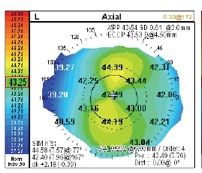Article
Astigmatism: A ‘clear-as-mud’ concept to patients
Author(s):

Special to Ophthalmology Times®
Astigmatism is something we treat every day in our cataract and refractive practices, yet it can be surprisingly hard to explain to patients.
In my experience, patients are generally confused by the analogy so many doctors use when they say, “Your eye is shaped like a football rather than a basketball.”
In today’s tech-savvy and visual world, that simple analogy doesn’t always resonate.
Related: Everything you thought you knew about astigmatism and dry eye is wrong
And yet, we ask patients to spend money-out of pocket-for correction of astigmatism with limbal relaxing incisions, a toric IOL, or laser vision correction.
If they don’t understand what the condition is or how the proposed treatment can help, patients may be hesitant to make that additional expenditure, and then end up unhappy when they don’t have good uncorrected vision.
Fortunately, there are many ways to use technology to help patients understand complex concepts like astigmatism.

Here are four patient education tools I like to use:
1. Tecnis Vision Simulator (Johnson & Johnson Vision)
This is available from the Apple app store (for iPad only) or online at www.tecnisvisionsimulator.com.
There is a slider at the bottom of the screen that you can move to simulate astigmatism and vision after surgery with a toric or standard monofocal IOL, during the day and at night (Figure 1a, seen above; Figure 1b, to the right).
Figure 1a: Simulation of vision with presbyopia and astigmatism after implantation of a standard monofocal.
This makes it obvious to the patient that vision won’t be as clear without correcting the astigmatism.
Related: Advanced toric IOL calculator improves refractive resources
2. The Nidek OPD-Scan III

I like to show patients the multicolor axial view of the corneal topography and ask if they see the “bowtie” shape (See Figure 2: The full color axial map on a topographer is a good way to help patients visualize that they have astigmatism), either standing up or lying down.
“That’s your astigmatism, and we can correct most of it,” I explain.
I also like the simulator on this device, which displays a beach scene with a boat. A lay person can see that when astigmatism is corrected, the image is crisp and clear.
When it is not corrected, there is more blur overall, which is especially noticeable on the edges and fine details of the boat.
Related: Color-LED topography measures corneas consistenly in analysis 3. CheckedUp
This is an interactive patient engagement platform that uses auditory, visual, and touch elements to help patients understand their conditions. We have CheckedUp wallboards in most of our exam rooms.
4. Rendia
I also utilize the educational videos from Rendia, where astigmatism is explained through easy-to-understand animation software. It can be sent to patients after the visit or shown in the office.
These are all 21st-century methods for showing patients what we mean by astigmatism, and most importantly, what it means for their lifestyle and visual function to correct astigmatism.
Read more by Dr. Matossian
Cynthia Matossian, MD, FACSE: cmatossian@matossianeye.com
Newsletter
Don’t miss out—get Ophthalmology Times updates on the latest clinical advancements and expert interviews, straight to your inbox.




